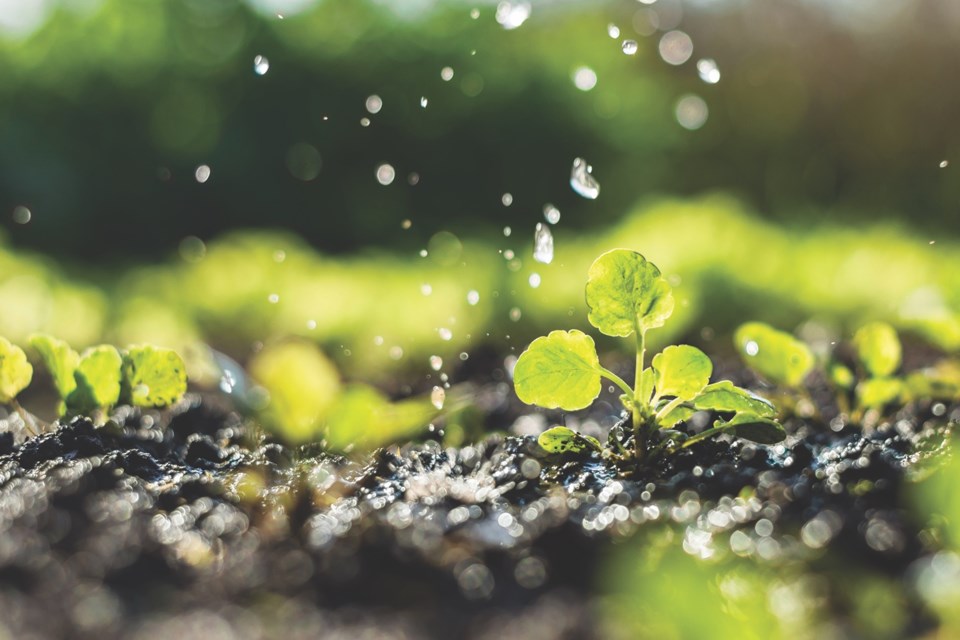These early season vegetables are easy to grow. Start them in late April or early May, as soon as the soil is workable. While carrots and peas need at least six hours of sunlight, lettuce, spinach, and Swiss chard do well on less. All need a soil amended with compost.
After planting the seeds, cover with a ¼ inch of soil and gently compact the soil so it is pressed against the seeds. Keep the surface moist until seeds germinate.
Carrots need a deep, soft, fluffy, somewhat sandy soil, with added compost to grow without forks or other blemishes. The deeper the soft soil, the longer the carrots will become. Plant in rows 6 inches apart. Because carrot seeds are small, take your time to ensure they are spread thinly; try for an inch apart.
Carrots take two weeks or more to germinate. Then thin to about 3 inches apart to get larger carrots and fewer deformed ones. Once the plants are large enough, add mulch to reduce surface evaporation. Water weekly for the first month as they develop their root structure. But don’t overdo it. In the middle of the season water every two weeks, depending on rainfall. As carrots mature, their rootlets can go down up to 7 feet and therefore you can water them less than other vegetables.
I prefer Nantes or Danvers seeds because they keep well. Nantes is an open pollinated seed variety, while Danvers is an heirloom seed variety.
There are three types of peas: edible pod such as sugar snap, edible pod with developed seeds, and shelling peas. There are many varieties available. Planting techniques are the same for all.
Soak dry seed peas for up to 12 hours before planting. Plant your peas in two rows spaced 10 inches apart, one on each side of a vertical support. The vertical support can be stucco wire, string stretched between poles, etc. Place each seed three inches apart in the row and cover with a half inch of soil. If properly supported, pea vines will grow up to seven feet tall. The taller they grow, the more pods they produce. Keep the soil moist; water to make up for a lack of rain.
Lettuce, spinach, and Swiss chard are shallow rooted plants. Plant in a partially shaded part of your garden, hopefully starting in early April. To ensure continuous crops of lettuce and spinach, plant in 6-foot rows every two weeks. Because they are leafy vegetables, they will benefit from a nitrogen fertilizer such as blood meal. Ensure the soil is well drained, but kept continually moist.
There are many varieties of lettuce. Romaine is the healthiest. Some other varieties include buttercrunch, ice berg, loose-leaf, and red leaf. Thin most lettuce plants to about six inches apart to ensure fast growth and tender, tasty leaves. Thin head lettuce to 12 inches apart.
Harvest leaf type lettuces as soon as the outside leaves are large enough to provide a meal. Harvest romaine or head lettuce when the heads are solid and firm.
Plant spinach seeds ¼ inch deep every two inches, then thin to six inches. Keep the soil moist, but not too wet. Spinach tends to bolt when the soil becomes too dry. Spinach matures in up to 50 days. Harvest individual leaves continuously once they get to a reasonable size. When the plants start to bolt, harvest the whole plant. Spinach may be frozen.
One 9-foot row of Swiss chard will feed a family of four over the summer. Plant seeds six inches apart and mulch once they are tall enough. To harvest, cut stalks off at the bottom and like magic, new ones grow back. Both the stalks and leaves are edible and palatable. Swiss chard is susceptible to Cercospora leaf spot and mildew. Inspect your plants daily and remove any infected leaves. Excess Swiss chard may be frozen.
Charles Schroder gardens in the Edmonton area.




